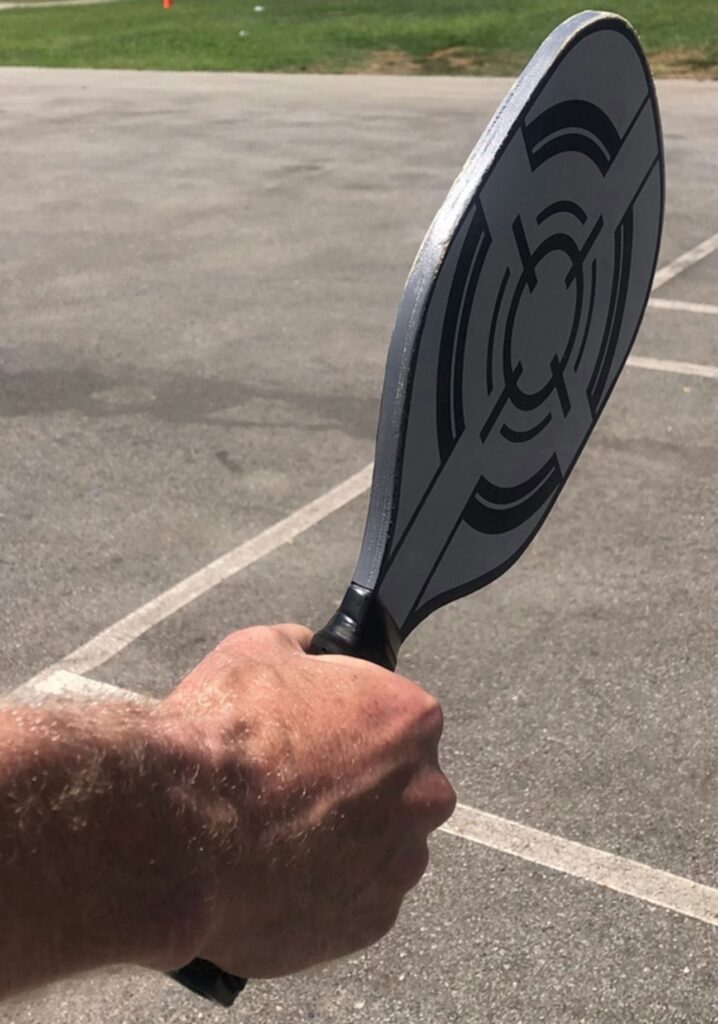
Paddle challenges offer an effective, engaging way to introduce children to Pickleball and prepare them for game play. In this post I recommend a set of challenges you can use with your elementary students, present differentiation options, describe the goals and benefits associated with this whole-class activity, and highlight its powerful, positive effects on class culture.
Getting Started
Each child needs to have their own paddle and ball. Different kinds of balls are made for indoor and outdoor play. Try to gather the type that matches your teaching location. Students scatter within an area large enough to provide sufficient space between neighbors. I suggest you stand front and center so the kids can easily watch you demonstrate each challenge. Before you model each new part, ask everyone to put their paddle and ball in home position to gain their full attention—paddle in front of their shoes and ball between their feet so it doesn’t roll away.
Recommended Sequence

Here is a suggested order of activities designed to help students develop the hand-eye coordination and visual tracking skills needed to progress to actual game play. Feel free to modify this sequence to suit your needs.
Grip & Grip Strength: Though a few valid options exist for gripping the paddle, I suggest the Continental Grip, otherwise known as the Handshake Grip, which involves holding the paddle as if you are shaking hands with it or holding the paddle like a hammer. This grip allows for easy transitions between forehand and backhand shots. Many players tend to hold the paddle too tightly. On a “grip strength” scale of 1-10, it is recommended that players aim for a 3 or 4. Employing a lighter grip typically leads to better shots and decreases the likelihood of elbow or forearm issues.
Roll & Control: We start with Roll & Control because it tends to provide the smoothest entry point and helps deliver immediate joy, success, and confidence to children, many of whom might still be making up their minds about a sport named after a cucumber preserved in brine. (Actually, Pickleball was named after the dog who contributed the ball its owners used to invent the game.) The object is to roll the ball around on the paddle face and keep it from falling to the ground. Whenever possible, creating multiple levels for an activity increases student engagement and enables everyone to find a “just right” level of challenge. Try the following levels for Roll & Control: (1) Stand and roll, (2) Walk and roll, (3) Walk, roll, and smile!
Frozen Statue: This redundantly-titled paddle challenge offers a nice contrast to the walking, rolling, and smiling of the previous activity. Ask, “Can you achieve total stillness?” Kids are usually able to bring their bodies and paddles to a complete stop. Getting that pesky ball to freeze, however, is a bit more difficult.
Ups: Ups will likely be an instant favorite among your students. Keeping the paddle face parallel to the ground, kids attempt to tap the ball in the air as many times as possible. Some students will want to count their “ups” or “taps” and aim for personal bests. Others will simply wish to enjoy the challenge of keeping the ball in the air. The key to achieving a high score involves maintaining a flat paddle surface. Rather than announce this tip, consider launching an inquiry and asking your students to find the most effective way to keep the ball in the air.
1-Bounce Ups: This activity is the same as the previous one, except that we allow the ball to bounce once between each “up.” For best results, students should hit up on the ball after each bounce so the ball reaches their head or just above it.
4-Way Choice of Ups: Both 1-bounce and no-bounce ups will offer an appropriate level of challenge to some of your students; others will want something more difficult. This is where “flip ups” come in. In a “flip up” we turn the paddle face over after every rep. Asking the kids to choose between 1-bounce and no-bounce ups, with the option of flipping the paddle face for either kind, serves as effective differentiation.
Apex Catches: With the paddle in one hand, we extend our other arm fully with the ball at forehead level. After releasing the ball, students try to “catch” the ball with their paddle once it has bounced and reached its highest point, its apex. Besides being an interesting challenge in its own right, apex catches also help students build two habits. First, it enables kids to learn that in Pickleball game play, we usually want to make contact when the ball reaches its apex, rather than lunging forward or reaching behind us to make contact. Second, dropping the ball from forehead level is the best way to initiate a rally, whether we are practicing with a partner or hitting alone against a handball wall.
Combos: This activity serves as the first of two opportunities that encourage student creativity. The directions are simple: Choose two or more of the previous challenges and combine them somehow, either by alternating between them or doing both at the same time.
Pickleball Buffet: If students have a favorite paddle challenge or one they are trying to master, they can spend additional time on it as part of our Pickleball Buffet.
Create! Encourage everyone to invent a new paddle challenge or add a fun twist to an existing one. Kids love trying to come up with clever ideas!
Bonus Tips
• At any point in the sequence, students who desire additional difficulty can attempt a given challenge with their non-dominant hand or with one leg lifted.
• Anyone seeking greater power or control of their paddle should feel free to use two hands. That’s how I developed my 2-handed backhand at the age of five, and I still use it today!
*A note of caution: Many lists of paddle challenges include striking down on the ball and “dribbling” as many times in a row as possible. Kids enjoy this move, but pickleballs tend not to have long life spans. This striking action only accelerates the demise of the balls. I recommend you omit this challenge and explain the reasoning to your classes.
The Benefits of Paddle Challenges:
In addition to helping students develop hand-eye coordination and visual tracking skills, learn important Pickleball concepts, and prepare for game play, paddle challenges offer less obvious, yet powerful, benefits.
• After serving as the opening activity of our Pickleball exploration, paddle challenges become our daily warmup for the remainder of the unit. This consistency sends an important message to our classes—no matter how advanced we may become in a given activity, we always continue working on our fundamentals. This type of practice may not be glamorous, but it’s vital for future success.
• The “spread out” formation we use with the teacher standing front and center and children immersed in each challenge enables us to create a positive vibe and strengthen our class culture right from the start—recognizing individual progress, giving shoutouts, and building enthusiasm. We can also circulate as the kids are engaged in each challenge, spending a moment with each child, sharing compliments, and making everyone feel special and noticed. These gestures can significantly strengthen the connections we have with our students.
• Our efforts to connect with individual children can also build confidence and pride. When students approach us to announce a new personal best, we can make a big deal out of it and reinforce their effort and determination. Corny responses such as “Get out of town!” or “No way!” add to the moment.
Related Pickleball Articles:
10 Fun, Flexible Ways to Energize PE with NowNets
Engaging Pickleball Activities for PE Classes
5 Small-Sided Pickleball Games for Skill Development [Video]
Shop Pickleball Equipment:








